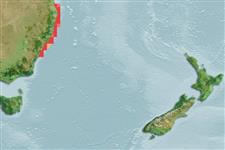Elasmobranchi (squali e razze) (sharks and rays) >
Heterodontiformes (Bullhead and horn sharks) >
Heterodontidae (Bullhead, horn, or Port Jackson sharks)
Etymology: Heterodontus: heteros (Gr.), different; odontos (Gr.), tooth, referring to pointy teeth (for clutching prey) at front of jaws, different than rounded molar-like teeth (for grinding hard-shelled invertebrates) at the back (See ETYFish); galeatus: Latin for helmeted, probably referring to high, enlarged supraorbital ridges or crest (See ETYFish).
More on author: Günther.
Environment: milieu / climate zone / distribuzione batimetrica / distribution range
Ecologia
marino associati a barriera corallina; distribuzione batimetrica 0 - 93 m (Ref. 54545). Temperate; 27°S - 35°S, 150°E - 155°E
Western Pacific: eastern Australia.
Length at first maturity / Size / Peso / Age
Maturità: Lm ?, range 70 - ? cm
Max length : 152 cm TL maschio/sesso non determinato; (Ref. 247); common length : 122 cm TL maschio/sesso non determinato; (Ref. 247); Età massima riportata: 12 anni (Ref. 72467)
Spine dorsali (totale) : 2; Spine anali: 0. Body with broad blackish bands or saddle markings (Ref. 9838).
Body shape (shape guide): elongated.
A moderately common benthic and epibenthic shark found on the continental shelf (Ref. 247, 43278). Occurs from close inshore to about 93 m depth (Ref. 247, 43278). Feeds primarily on sea urchins, but also on crustaceans, mollusks, and small fishes (Ref. 31369). Oviparous, egg cases spirally flanged and with long tendrils (Ref. 6871). Hatches at about 22 cm (Ref. 6871).
Oviparous, paired eggs are laid. Embryos feed solely on yolk (Ref. 50449). Distinct pairing with embrace (Ref. 205).
Compagno, L.J.V., 1984. FAO Species Catalogue. Vol. 4. Sharks of the world. An annotated and illustrated catalogue of shark species known to date. Part 1 - Hexanchiformes to Lamniformes. FAO Fish. Synop. 125(4/1):1-249. Rome, FAO. (Ref. 247)
IUCN Red List Status (Ref. 130435: Version 2025-1)
Threat to humans
Traumatogenic
Human uses
Pesca: scarso interesse commerciale
Strumenti
Special reports
Download XML
Fonti Internet
Estimates based on models
Preferred temperature (Fonte Biblio.
123201): 20.2 - 24, mean 21.8 °C (based on 16 cells).
Phylogenetic diversity index (Fonte Biblio.
82804): PD
50 = 0.5029 [Uniqueness, from 0.5 = low to 2.0 = high].
Bayesian length-weight: a=0.00380 (0.00165 - 0.00876), b=3.15 (2.95 - 3.35), in cm total length, based on LWR estimates for this (Sub)family-body shape (Ref.
93245).
Trophic level (Fonte Biblio.
69278): 3.7 ±0.53 se; based on food items.
Resilienza (Fonte Biblio.
120179): Molto basso, tempo minimo di raddoppiamento della popolazione più di 14 anni (tm=11.8).
Fishing Vulnerability (Ref.
59153): Very high vulnerability (90 of 100).
🛈
Nutrients (Ref.
124155): Calcium = 2.87 [0.37, 11.82] mg/100g; Iron = 0.113 [0.027, 0.319] mg/100g; Protein = 19.5 [17.2, 21.5] %; Omega3 = 0.198 [0.078, 0.467] g/100g; Selenium = 7.8 [2.2, 24.7] μg/100g; VitaminA = 33.2 [8.1, 135.9] μg/100g; Zinc = 0.439 [0.206, 0.907] mg/100g (wet weight);
